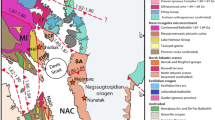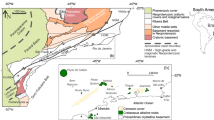Abstract
The Rae Craton, northern Canada, contains several diamondiferous kimberlite fields that have been a focus of episodic diamond exploration. Relatively little is known about the deep mantle lithosphere underpinning the architecturally complex crust. We present bulk and mineral element and isotopic compositional data for peridotite and pyroxenite/eclogite xenoliths from the Darby kimberlites representing fragments of the west central Rae lithosphere, as well as the first kimberlite eruption age of 542.2±2.6 Ma (2 σ; phlogopite Rb-Sr isochron). Darby peridotites have low bulk Al2O3 contents with highly-depleted olivine (median Mg# = 92.5) characteristic of cratonic lithosphere globally, but more depleted than peridotites from other Rae Craton localities. One peridotite xenolith contains a harzburgitic G10D garnet. Re-Os TRD model ages appear to be the oldest measured to date from peridotites of the Rae lithosphere, having a mode in the early Neoarchean and ranging to the Paleoproterozoic (~2.3 Ga). Concentrate clinopyroxene defines a well constrained mantle geotherm indicating the existence of a ~200 km thick lithosphere at the time of kimberlite eruption, greater than the lithospheric thickness beneath Somerset Island and in good agreement with modern seismic constraints. Nickel-in-garnet thermometry in grains that record temperatures below the mantle adiabat, indicates mantle sampling dominantly in the graphite stability field whereas Al-in-olivine thermometry shows a distinct mantle sampling mode in the diamond stability field. Abundant pyroxenite and eclogite xenoliths are recovered across the Darby property and low-Cr garnet (Cr2O3 < 1 wt%) is the most abundant garnet type recovered in kimberlite concentrate. Based on thermometry, these rocks range in likely depths of equilibration, from the lower crust into the shallow lithospheric mantle. They give variable Os model ages, with the oldest ages in the Mesoarchean. The abundance of this mafic material reflects derivation from a large mafic body possibly evident in the layered structure of the Rae Craton mantle root defined by new seismic studies.











Similar content being viewed by others
References
Andersen T (2002) Correction of common lead in U–Pb analyses that do not report 204Pb. Chem Geol 192:59–79
Aulbach S, Mungall JE, Pearson DG (2015) Distribution and processing of highly siderophile elements in cratonic mantle lithosphere. Rev Mineral Geochem 81:239–304
Berman RG, Pehrsson S, Davis WJ, Ryan JJ, Qui H, Ashton KE (2013) The Arrowsmith orogeny: geochronological and thermobarometric constraints on its extent and tectonic setting in the Rae Craton, with implications for pre-Nuna supercontinent reconstruction. Precambrian Res 232:44–69
Bostock MG (1998) Mantle stratigraphy and evolution of the Slave Province. J Geophys Res 103(B9):183–200
Boyd FR, Mertzman SA (1987) Composition and structure of the Kaapvaal lithosphere, South Africa. Magmatic Processes: Physicochemical Principles. Geo Soc S P No. I. 13–24
Bussweiler Y, Brey GP, Pearson DG, Stachel T, Stern RA, Hardman MF, Kjarsgaard BA, Jackson SE (2017) The aluminum-in-olivine thermometer for mantle peridotites — experimental versus empirical calibration and potential applications. Lithos 272-273:301–314
Canil D (1999) The Ni-in-garnet geothermometer: calibration at natural abundances. Contrib Mineral Petrol 136:240–246
Cherniak DJ (2000) Pb diffusion in rutile. Contrib Mineral Petrol 139:198–207
Counts B (2008) http://www.marketwired.com/press-release/indicator-minerals-darby-project-yields-more-kimberlite-partner-increases-budget-tsx-venture-ime-884912.htm. Accessed 12 May 2018
Creaser RA, Gru H, Carlson J, Crawford B (2004) Macrocrystal phlogopite Rb–Sr dates for the Ekati property kimberlites, Slave Province, Canada: evidence for multiple intrusive episodes in the Paleocene and Eocene. Lithos 76:399–414
Dawson JB, Stephens WE (1975) Statistical classification of garnets from kimberlite and associated xenoliths. J Geol 83(5):589–607
Desmons J, Smulikowski W (2007) A systematic nomenclature for Metamorphic rocks: 4. In: High P/T metamorphic rocks. Recommendations by the IUGS Subcommission on the Systematics of Metamorphic Rocks. SCMR website. www.bgs.ac.uk/SCMR
Foley SF, Prelevic D, Rehfeldt T, Jacob DE (2013) Minor and trace elements in olivines as probes into early igneous and mantle melting processes. Earth Planet Sci Lett 363:181–191
Griffin WL, Cousens DR, Ryan CG, Sie SH, Suter GF (1989) Ni in chrome pyrope garnets: a new geothermometer. Contrib Mineral Petrol 103(2):199–202
Grütter HS (2009) Pyroxene xenocryst geotherms: techniques and application. Lithos 112S:1167–1178
Grütter HS, Gurney JJ, Menzies AH, Winter F (2004) An updated classification scheme for mantle-derived garnet, for use by diamond explorers. Lithos 77:841–857
Grütter HS, Latti D, Menzies A (2006) Cr-saturation arrays in concentrate garnet compositions from kimberlite and their use in mantle barometry. J Petrol 47(4):801–820
Hardman MF, Pearson DG, Stachel T, Sweeney RJ (2018) Statistical approaches to the discrimination of crust- and mantle-derived low-Cr garnet -- major-element-based methods and their application in diamond exploration. J Geochem Explor 186:24–35
Hardman MF, Pearson DG, Stachel T, Sweeney RJ (2018) Statistical approaches to the discrimination of mantle- and crust-derived low-Cr garnets using major and trace element data. Miner Petrol, this volume
Harte B, Kirkley MB (1997) Partitioning of trace elements between clinopyroxene and garnet: data from mantle eclogites. Chem Geol 136:1–24
Harte B, Jackson PM, Macintyre RM (1981) Age of mineral equilibria in granulite facies nodules from kimberlites. Nature 291:147–148
Hartlaub RP, Chacko T, Heaman LM, Creaser RA, Ashton KE, Simonetti A (2005) Anchient (Meso- to Paleoarchean) crust in the Rae Province, Canada: evidence from Sm-Nd and U-Pb constraints. Precambrian Res 141:137–153
Irvine GJ, Pearson DG, Kjarsgaard BA, Carlson RW, Kopylova MG, Dreibus G (2003) A Re – Os isotope and PGE study of kimberlite-derived peridotite xenoliths from Somerset Island and a comparison to the Slave and Kaapvaal cratons. Lithos 71:461–488
Jackson GD (1966) Geology and mineral possibilities of the Mary River region, northern Baffin Island. Can Miner 87:57–61
Jacob DE (2004) Nature and origin of eclogite xenoliths from kimberlites. Lithos 77(1–4):295–316
Jacob DE, Schmickler B, Schulze DJ (2003) Trace element geochemistry of coesite-bearing eclogites from the Roberts Victor kimberlite, Kaapvaal Craton. Lithos 71:337–351
Jagoutz E, Dawson JB, Hoernes S, Spettel B, Wänke H (1984) Anorthositic oceanic crust in the Archean Earth. 15th Lunar Planet Sci Conf, Abs 395–396
Kjarsgaard BA (2007) Kimberlite diamond deposits. In: W. Goodfellow (eds) Mineral deposits of Canada. Geological Association of Canada Mineral Deposits Division Special Publication, vol 5, pp 245–272
Klein-BenDavid O, Pearson DG (2009) Origins of subcalcic garnets and their relation to diamond forming fluids-case studies from Ekati (NWT-Canada) and Murowa (Zimbabwe). Geochim Cosmochim Acta 73(3):837–855
Krogh RE (2000) The garnet – clinopyroxene Fe2+ − Mg geothermometer: an updated calibration. J Metamorph Geol 18:211–219
Liu J, Riches AJV, Pearson DG, Luo Y, Kienlen B, Kjarsgaard BA, Stachel T, Armstrong JP (2016) Age and evolution of the deep continental root beneath the central Rae Craton, northern Canada. Precambrian Res 272:168–184
MacHattie T (2008) Geochemistry and Geochronology of the Late Archean Prince Albert Group (PAG), Nunavut, Canada. Ph.D. thesis, University of Alberta, pp 61–63
Malkovets VG, Rezvukhin DI, Belousova EA, Griffin WL, Sharygin IS, Tretiakova IG, Gibsher AA, O’Reilly SY, Kuzmin DV, Litasov KD, Logvinova AM, Pokilenko NP, Sobolev NV (2016) Cr-rich rutile: a powerful tool for diamond exploration. Lithos 265:304–311
Marchesi C, Dale CW, Garrido CJ, Pearson DG, Bosch D, Bodinier J, Gervilla F, Hidas K (2014) Fractionation of highly siderophile elements in refertilized mantle: implications for the Os isotope composition of basalts. Earth Planet Sci Lett 400:33–44
Mather KA, Pearson DG, McKenzie D, Kjarsgaard B, Priestley K (2011) Constraining the depth and thermal history of cratonic lithosphere using peridotite xenolith and xenocryst thermobarometry and seismology. Lithos 125:729–742
Maynes A, Doulos D (2007) Assessment report on the Darby Property 2006 diamond exploration program, ground and airborne geophysics, drilling, and heavy mineral sampling. Unpublished report prepared by Indicator minerals Inc
McDonough WF, Sun S-S (1995) The composition of the Earth. Chem Geol 120:223–253
Menzies A (2003) Re–Os systematics of diamond-bearing eclogites from the Newlands kimberlite. Lithos 71(2–4):323–336
Pearson DG, Wittig N (2008) Formation of Archaean continental lithosphere and its diamonds: the root of the problem. J Geol Soc Lond 165:895–914
Pearson DG, Wittig N (2014) 3.6 - the formation and evolution of the subcontinental mantle lithosphere - evidence from mantle xenoliths. In: Treatise of geochemistry, 2nd edn. Elsevier, Oxford, pp 255–292
Pearson DG, Woodland SJ (2000) Solvent extraction/anion exchange separation and determination of PGEs (Os, Ir, Pt, Pd, Ru) and Re-Os isotopes in geological samples by isotope dilution ICP-MS. Chem Geol 165(1–2):87–107
Pearson DG, Davies GR, Nixon PH (1993) Geochemical constraints on the petrogenesis of diamond facies pyroxenites from the Beni Bousera peridotite massif, North Morocco. J Petrol 34:125–172
Pearson DG, Kelley SP, Pokhilenko NP, Boyd FR (1997) Laser 40Ar/39Ar analyses of phlogopites from southern African and Siberian kimberlites and their xenoliths: constraints on eruption ages, melt degassing and mantle volatile compositions. Russ Geol Geophys 38:106–117
Pearson DG, Irvine GJ, Ionov DA, Boyd FR, Dreibus GE (2004) Re – Os isotope systematics and platinum group element fractionation during mantle melt extraction: a study of massif and xenolith peridotite suites. Chem Geol 208:29–59
Prelević D, Foley SF, Romer R, Conticelli S (2008) Mediterranean Tertiary lamproites derived from multiple source components in postcollisional geodynamics. Geochim. Cosmochim. Acta 72:2125–2156
Regan SP, Williams ML, Mahan KH, Dumond G, Jercinovic MJ, Orlandini OF (2017) Neoarchean arc magmatism and subsequent collisional orogenesis along the eastern Rae domain, western Churchill Province: implications for the early growth of Laurentia. Precambrian Res 294:151–174
Sanborn-Barrie M, Davis WJ, Berman RG, Rayner N, Skulski T, Sandeman H (2014) Neoarchean continental crust formation and Paleoproterozoic deformation of the central Rae craton, Committee Bay belt, Nunavut. Can J Earth Sci 51:635–667
Sarkar C, Heaman LM, Pearson DG (2015) Duration and periodicity of kimberlite volcanic activity in the Lac de Gras kimberlite field, Canada and some recommendations for kimberlite geochronology. Lithos 218:155–166
Sarkar C, Kjarsgaard BA, Pearson DG, Heaman LM, Locock A, Armstrong JA (2018) Geochronology, classification and mantle source characteristics of kimberlites and related rocks from the Rae Craton, Melville Peninsula, Nunavut, Canada. Miner Petrol, this volume
Schau M (1982) Geology of the Prince Albert Group in parts of the Walker Lake and Laughland Lake map areas, district of Keewatin. Geol Surv Canada, Bull 337:1–75
Schultz MEJ, Chacko T, Heaman LM, Sandeman HA, Simonetti A, Creaser RA (2007) Queen Maud block: a newly recognized Paleoproterozoic (2.4–2.5 Ga) terrane in northwest Laurentia. Geology 35(8):707–710
Schulze DJ (1989) Constraints on the abundance of eclogite in the upper mantle. J Geophys Res 94(B4):4205–4212
Shu Q, Brey GP, Gerdes A, Hoefer HE (2013) Geochronological and geochemical constraints on the formation and evolution of the mantle underneath the Kaapvaal craton: Lu-Hf and Sm-Nd systematics of subcalcic garnets from highly depleted peridotites. Geochim Cosmochim Acta 113:1–20
Snyder DB, Craven JA, Pilkington M, Hillier MJ (2015) The 3-dimensional construction of the Rae Craton, central Canada. Geochem Geophys Geosyst 16:3555–3574
Snyder DB, Humphreys E, Pearson DG (2017) Tectonophysics construction and destruction of some North American cratons. Tectonophysics 694:464–485
Stachel T, Harris JW (2008) The origin of cratonic diamonds – constraints from mineral inclusions. Ore Geol Rev 34(1–2):5–32
Wang H, Van Hunen J, Pearson DG (in press) Making Archean cratonic roots by lateral compression: a two-stage thickening and stabilization model. Tectonophysics, in press
Yavuz F (2013) WinPyrox: a Windows program for pyroxene calculation classification and thermobarometry. Am Mineral 98:1338–1359
Yaxley GM, Green DH (1998) Reactions between eclogite and peridotite: mantle refertilisation by subduction of oceanic crust. Schweiz Miner Pertrog 78:243–255
Acknowledgements
This research formed part of G.H.’s MSc. thesis funded by a Canada Excellence Research Chair (CERC) grant to D.G.P. and the Diamond Exploration and Research Training School (DERTS). We acknowledge Teck Resources Limited for granting access to the Darby property and support with field costs. Mike Merante provided invaluable assistance in the field. Unpublished data were provided by Bluestone Resources Inc. We thank Drs. Sarah Woodland, Andrew Locock, and Yan Luo for analytical assistance. We thank Grant Lockhart, Janina Czas, and Pedro Waterton for useful discussions. We are indebted to Véronique Le Roux, Richard Carlson and handling editor Roberta Rudnick for constructive comments that helped to improve the manuscript.
Author information
Authors and Affiliations
Corresponding author
Additional information
Editorial handling: R. Rudnick
Rights and permissions
About this article
Cite this article
Harris, G.A., Pearson, D.G., Liu, J. et al. Mantle composition, age and geotherm beneath the Darby kimberlite field, west central Rae Craton. Miner Petrol 112 (Suppl 1), 57–70 (2018). https://doi.org/10.1007/s00710-018-0609-4
Received:
Accepted:
Published:
Issue Date:
DOI: https://doi.org/10.1007/s00710-018-0609-4




